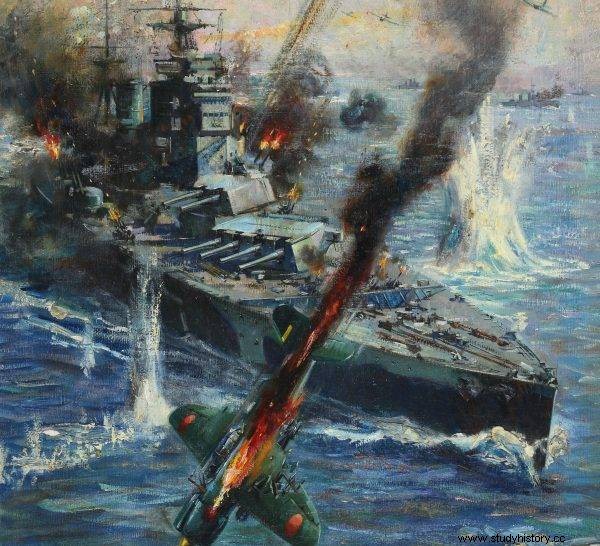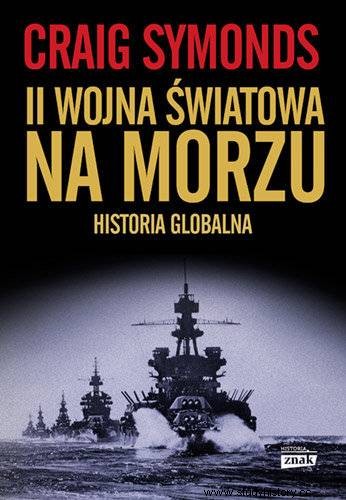The rally at Pearl Harbor was just one part of Japan's great strategy. The actual goal of all her plans - at the time when Japanese planes were destroying the American navy - was to take control of the resource-rich areas to the south.
On December 4 and 5, when Nagumo directed his aircraft carriers southwest (and Zhukov was gathering divisions near Moscow), Japanese invasion teams left Hainan Island in the South China Sea and Cam Ranh Bay in Indochina and headed south to the Gulf of Siam.
When the first planes took off from Vice Admiral Nagumo's carriers, the Japanese invasion force of twenty-one transporters escorted by a light cruiser and four destroyers began landing on the north coast of British Malaya, in Kota Baharu, just below the Siam border.
Ninety minutes later (when Lieutenant Commander Fuchida's planes were lining up to attack the line of battleships) the second invasion team - twenty-two transport ships escorted by the battleship, five cruisers, and seven destroyers - began landing troops on a beach at Songkhla, Siam territory, 210 kilometers north from the Kra isthmus (...).
Force Z
At Songkhla, the Siamese defenders fought for several hours without much conviction until their government decided that the wisest option was to accept Japanese occupation. Ultimately, Siam signed an agreement guaranteeing the Japanese can march through the country and use its transportation system.
In Kota Baharu, the fighting took a little longer and the British 8th Indian Brigade sank one of the Japanese transports and damaged two others before being forced to resign. Bad weather disrupted British aerial counterattack attempts, and Japanese Zero fighters clearly outnumbered the British Brewster B-339 Buffalo fighters. By December 9, the Japanese had full control of the beachhead at Kota Baharu and began their march inland.
British planners in London, including Dudley Pound and Churchill, had long been aware of the Japanese threat to the Malayans, but by focusing on the war in Europe, they were reluctant to add another front or enemy and, like the Americans, focused their efforts primarily on on keeping Japan from aggression (…).

The British suffered a disastrous defeat against the Japanese in the Pacific.
Churchill originally wanted to add the new aircraft carrier Indomitable to the strike, but the ship ran aground during sea trials in the West Indies and had to be shipped to a shipyard for repairs. Therefore, ultimately only the Prince of Wales and Repulse, accompanied by four destroyers, reached Singapore, where they arrived on December 2.
The fact that there was no carrier with them was considered acceptable as the necessary air cover could be provided by planes from bases on the Malaya coast . In addition, these ships - called Force Z - were designed to impress the Japanese, not fight them.
Learn more:War in the Pacific. Unusual actions of American submarines
"We're looking for trouble and we'll find it"
The battleship "Prince of Wales" was still commanded by Commander John Leach, but the Commander-in-Chief of Force Z was Admiral Tom Phillips, who was known as "Tom Thumb" (Tomcio Paluch) due to his stature (about 160 centimeters).
Upon arriving in Singapore on December 2, his first step was to fly to Manila to coordinate plans with his counterpart in the US fleet, Admiral Thomas C. Hart. He returned to Singapore on December 7, where he learned a few hours later that the Japanese had destroyed the American navy at Pearl Harbor and that this new common enemy was just landing in Kota Baharu.

The text is an excerpt from the book "World War II at Sea. Global History ”by Craig Symonds. The book was published by the Znak Horyzont publishing house.
Previous plans that his ships were meant to be used as a deterrent now collapsed. (...) Phillips set out to sea on the evening of December 8, leading two battleships and four destroyers with him, and headed southeast for the South China Sea.
He intended to go north until he was in front of the Japanese bridgehead, then turn west and strike the invasion fleet from the sea. When both ships left the port, the commander of the "Repulse" Commander William Tennant addressed the crew with a short speech:"We are looking for trouble," he began, "and I hope to find them" (...).
Phillips believed he still had a chance to surprise the invaders, if only not detected too soon. His greatest hope - and in fact his only chance - was to find the enemy fleet before he himself was cornered by Japanese planes . He did not know, however, that it had already been spotted by the Japanese submarine I-56, which reported its position, course and speed (...).
"I've never felt so helpless"
On December 10, the sun rose at 6.00. At that time, "Prince of Wales" and "Repulse" were rapidly approaching the shores of Malaya. Within an hour, Phillips was able to convince himself that there were no Japanese forces in Kuantan, nor had they ever been there (...).
As Phillips stared at the empty shoreline near Kuantan, Matsunaga dispatched his airborne armada of Nell and Betty bombers to try again to locate the British battleships . This time, shortly after ten in the morning on December 10, they found them (…).
To attack British ships, the Japanese deployed eighty-eight aircraft, sixty-one of which were armed with torpedoes. During the first attack, nine Nell bombers dropped bombs from a height of three and a half thousand meters, which fell right next to the ships.

One of the bombs struck the amidships of the Repulse. Fifteen minutes later sixteen Betty bombers torpedoed the Prince of Wales.
The sea almost boiled from the explosion, and one of the bombs struck the amidships of the Repulse, where it did only minor damage. Fifteen minutes later, sixteen Betty bombers, breaking through a wall of anti-aircraft fire, launched a torpedo attack on the Prince of Wales.
With so many planes attacking from all directions, Leach had no chance of maneuvering to avoid all of them. The lieutenant of the battleship Prince of Wales watched as the "narrow pale green streak of rising bubbles" headed straight for the bow of the ship. "I've never felt so helpless," he later recalled (...).
"We were defenseless everywhere"
An hour later, the Japanese reappeared. Repulse finally broke the radio silence to send the message:"Enemy bombing." He caused the command in Singapore to send fighters, although they arrived much too late.
Three torpedoes struck the Prince of Wales - one forward, one amidships and one aft - and three more struck the Repulse shortly after. The commander of the "Repulse" William Tennant ordered the crew to go aboard, which must have saved several hundred lives, because at 12.33 pm the large battlecruiser fell over and went to the bottom.
The Prince of Wales remained afloat less than forty-five minutes longer and sank at 1:18 PM as well. The accompanying British destroyers, undisturbed by the Japanese, picked up more than two thousand survivors from the water, although eight hundred and forty men, including John Leach and Tom Phillips, were killed. The Japanese, having only lost three planes, withdrew at the exact same moment that Singapore's Buffalo fighter squadron arrived.
In London, the news hit Churchill with almost physical force. "Throughout the war," he later wrote, "I never experienced a greater shock." . It was more than the loss of two important ships or even the loss of eight hundred and forty men. It was the realization that this defeat had completely exposed the British Empire in South Asia.
Coupled with the destruction of the American fleet at Pearl Harbor, this meant that there were now no major Allied ships between Ceylon and Hawaii. The distance between them is almost 13,000 kilometers, a third of the circumference of the Earth. "In these vast territories," Churchill later wrote, "Japan was now ruling, and we were defenseless everywhere."
Source:
The text is an excerpt from the book "World War II at Sea. Global History 'by Craig Symonds. The book was published by Znak Horyzont Publishing House.
